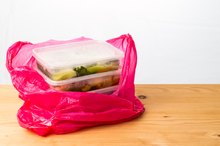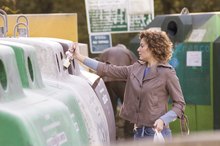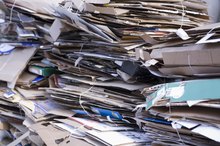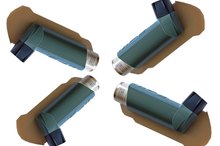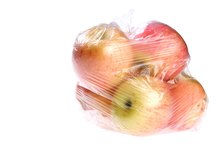What Goes in the Recycling Bin?
What goes into the recycling bin depends on where you live and what kinds of recyclable materials your municipal area picks up. Generally, recyclable materials fall into four categories: paper, plastic, glass and metal. Some plastics and paper products are not recyclable and should be put in with the regular trash. Knowing what you can and cannot put into the recycling bin can help you make more informed choices when shopping for products.
Glass
Most glass can be recycled, but it is usually sorted according to color. What goes into your recycling bin depends on your municipality’s recycling program. Some areas require you to sort glass into separate bins for brown, green and clear glass, while other areas use single-stream recycling programs that allow you to place all glass into one recycling bin 2. Recycling glass uses about 40 percent less energy to reuse glass in the production of new glass products 2. You cannot put tempered glass into your recycling bin 2.
Paper and Cardboard
The Advantages of Biodegradable Products
Learn More
Paper is perhaps the broadest category of recyclable materials that can go into your recycling bin. Computer paper, paper bags, newspapers and magazines, brochures and other printed materials such as business cards and envelopes can be recycled. Paperboard products like cereal boxes can go into the recycling bin, and so can corrugated cardboard boxes and egg crates. Recycling paper removed about 77 million tons of material from landfills in 2008, according to the EPA.
- Paper is perhaps the broadest category of recyclable materials that can go into your recycling bin.
- Paperboard products like cereal boxes can go into the recycling bin, and so can corrugated cardboard boxes and egg crates.
Aluminum
Aluminum is the most abundant metal on Earth, but recycling aluminum cans uses up to 95 percent less energy than it takes to make new cans from virgin metal. More than half of the aluminum cans collected for recycling make it back to the store shelves within two months. You can place aluminum cans, aluminum foil baking pans and aluminum foil into your recycling bin.
Other Metals
Examples of Waste Recycling
Learn More
Steel and tin food cans go in the recycling bin. Other common household metals include wire coat hangers, bottle caps and empty paint cans, including aerosol cans. Other recyclable metals, including copper and aluminum wire, brass and other nonferrous metals, are recyclable but are usually not included in things that you can place in your recycle bin. Cast-iron radiators and pipe can be sent to a metal salvage yard.
- Steel and tin food cans go in the recycling bin.
- Other recyclable metals, including copper and aluminum wire, brass and other nonferrous metals, are recyclable but are usually not included in things that you can place in your recycle bin.
Plastics
Plastics can be made from a variety of chemicals, but all of them are recyclable. Some plastics can go straight into the recycling bin, but if you have containers that have held motor oil or garden chemicals, you should check with your municipality to make sure that you can recycle those materials. Plastics are marked with a number that signifies what they are made from. Polyethylene terephthalate, or PET, is commonly used for soda bottles and can go right into the recycling bin.
- Plastics can be made from a variety of chemicals, but all of them are recyclable.
- Some plastics can go straight into the recycling bin, but if you have containers that have held motor oil or garden chemicals, you should check with your municipality to make sure that you can recycle those materials.
Special Recycling Needs
Some materials are recyclable but do not go into the recycling bin. Fluorescent light bulbs, including the new energy-efficient compact bulbs, contain small amounts of mercury and cannot be put into the recycling bin. When in doubt, call your city and ask what you can put in your bin.
Related Articles
References
Resources
Writer Bio
Karen S. Garvin has been a professional writer since 1988, when "Dragon" magazine published her first article. Her recent work includes encyclopedia entries on historical subjects. She holds a bachelor’s degree in communications and is pursuing a master's degree in European history. Her interests include photography, science, history and Steampunk.
